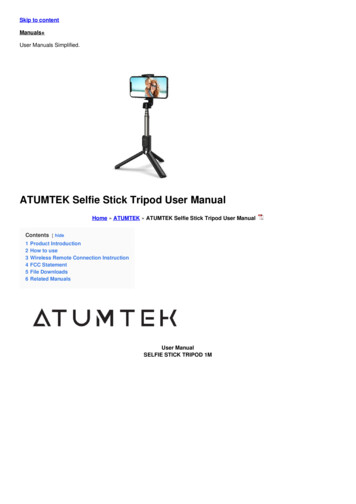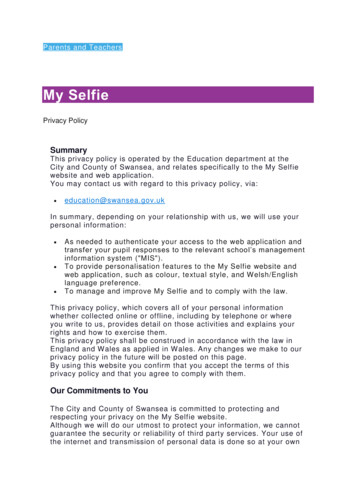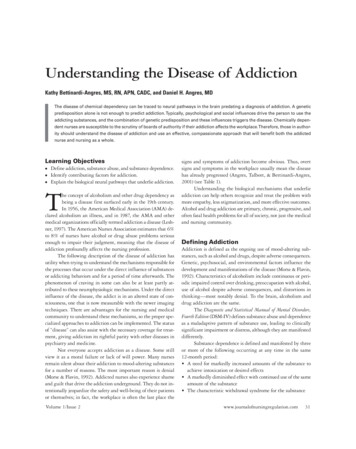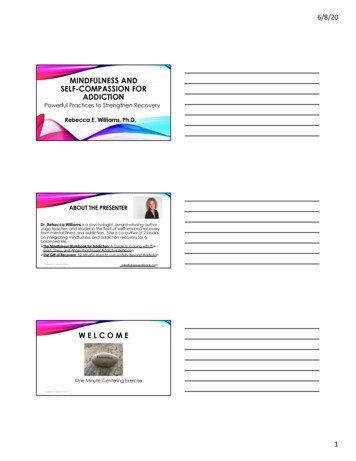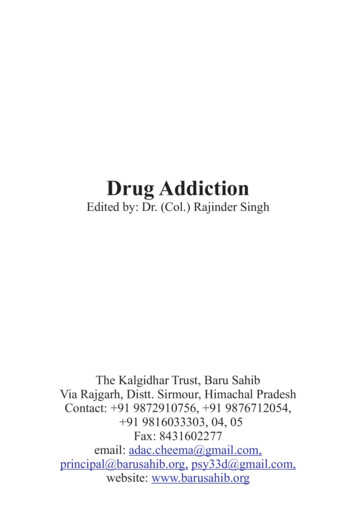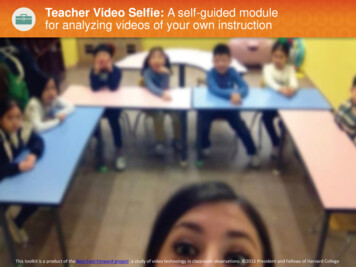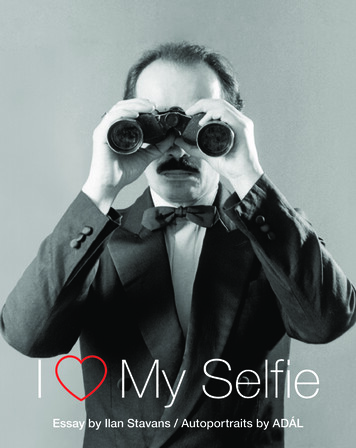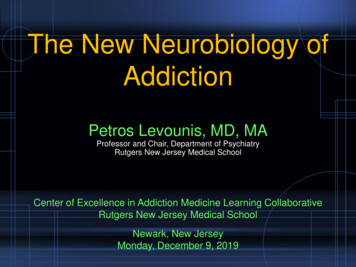
Transcription
Factors Underlie Selfie Addiction:Developing and Validating a ScaleKhalid Ismail MustafaKoya University, IraqZhwan Dalshad AbdullahKoya University, IraqRenas Osman AbdulrahmanKoya University, Iraqwww.ijres.netAzad Ali IsmailKoya University, IraqTo cite this article:Mustafa, K. I., Abdullah, Z. D., Abdulrahman, R. O., & Ismail, A. A. (2021). Factorsunderlie selfie addiction: Developing and validating a scale. International Journal ofResearch in Education and Science (IJRES), 7(1), 82-92. https://doi.org/10.46328/ijres.1453The International Journal of Research in Education and Science (IJRES) is a peer-reviewed scholarly onlinejournal. This article may be used for research, teaching, and private study purposes. Authors alone areresponsible for the contents of their articles. The journal owns the copyright of the articles. The publishershall not be liable for any loss, actions, claims, proceedings, demand, or costs or damages whatsoever orhowsoever caused arising directly or indirectly in connection with or arising out of the use of the researchmaterial. All authors are requested to disclose any actual or potential conflict of interest including anyfinancial, personal or other relationships with other people or organizations regarding the submitted work.This work is licensed under a Creative Commons Attribution-NonCommercial-ShareAlike 4.0 International License.International Journal of Research in Education and Science (IJRES) is affiliated with theInternational Society for Technology, Education, and Science (ISTES): www.istes.org
International Journal of Research in Education and Science2021, Vol. 7, No. 1, 82-92https://doi.org/10.46328/ijres.1453Factors Underlie Selfie Addiction: Developing and Validating a ScaleKhalid Ismail Mustafa, Zhwan Dalshad Abdullah, Renas Osman Abdulrahman, Azad Ali IsmailArticle InfoAbstractArticle HistoryThis study aimed at investigating the underlying factors of selfie addictionReceived:among university students. It further attempted to find out the role of gender30 May 2020difference in selfie addiction. A 19-item self-developed questionnaire used toAccepted:10 October 2020measure selfie addiction. The questionnaire was validated using a sample of 269randomly selected university students. Principle Component Analysis (PCA) wasconducted to test the validity of the questionnaire. The results revealed threeunderlined factors which were: Intention, Self-Obsessed, and Self-Acceptance.KeywordsSelfie addictionSelf-acceptanceThe results also indicated that females are more addicted with respect to selfieson social media than their males.IntentionSelf-obsessedIntroductionSelfie taking has spread increasingly across different age groups and has become ubiquitous with everyday life(Roberts & Koliska, 2017; Moon et al., 2016). Social networking platform users utilize various types ofpictures, particularly selfies, to display their personalities, lifestyles, and preferences (Sung et al., 2016).“Selfie” has been defined in Oxford Dictionary (2003) as a: “photograph that one has taken of oneself, typicallyone taken with a Smartphone or webcam and, uploaded to a social media website”. It has been also defined byother researchers as a digital self-portrait that is aided by the technological explosion of front-facing mobilecameras, photo-editing software and multiple social media platforms (Shah & Tewari, 2016). Kiprin (2013)defined it as a photo taken by an individual using any hand-held device (e.g., phone, iPad), whether or not theintention is to share it online. Selfie includes also photographs taken of oneself with a partner or a group ofpeople (Sorokowski et al., 2015).Selfie, as a new social phenomenon warrants greater academic attention which needs more investigation aboutthe intention behind selfie taking. Although, little is known about the selfie addiction in general, selfies haverecently received increasing attention from researchers and practitioners in psychology and communication asthey represent image r 2017.Brown, A.A., Freis, S.D., Carroll, P.J., & Arkin, R.M. (2016). Perceived agency mediates the link between thenarcissistic subtypes and self-esteem. Personality and Individual Differences erpsychology: Journal of Psychosocial Research on Cyberspace.10(2):7.Chua T.H.H. & Chang L. (2016). Follow me and like my beautiful selfies: Singa-pore teenage girls‟engagement in self-presentation and peer comparison on social media. Computers in HumanBehavior 55 (1):190–197. doi:10.1016/j.chb.2015.09.011.Colley, A. & Maltby, J. (2008). Impact of the Internet on our lives: Male and female personal perspectives.Computers in human behavior 24 (5):2005-2013.Dhir, A., Kaur, P., Lonka, K., & Nieminen, M. (2016a). Why do adolescents untag photos on Facebook?Computers in Human Behavior 55:1106-1115. tos-on-facebook-.htmlDhir, A., Pallesen, S., Torsheim, T., and Andreassen, C.S. (2016b). Do age and gender differences exist .chb.2016.05.044Dhir, A. (2015). On the nature of Internet addiction: What is it and how is it measured? 978-951-51-1119-7. doi:10.1016/j.paid.2015.10.055.Duggan, M., Ellison, N.B., Lampe, C., Lenhart, A., & Madden, M. (2015). Social media update 2014. Pewresearch center 9. Retrieved on July 24, 2018 from: http://www.pewinternet.org/ 2015/01/09/socialmedia-update-2014/.90
International Journal of Research in Education and Science (IJRES)Giroux, H. A. (2015). Selfie culture in the age of corporate and state surveillance. Third Text 29 (3):155-164.doi: 10.1080/09528822.2015.1082339.Griffiths, M.D. (2018). Obsessive Selfie-Taking: A brief overview of "selfitis." Psychology Today, Posted Jan12, 2018.Fabrigar, L.R., Wegener, D.T., MacCallum, R.C. & Strahan, E.J. (1999). Evaluating the Use of ExploratoryFactor Analysis in Psychological Research, Psychological Methods, 4(3): 272-299.Haferkamp, N., Eimler, S.C., Papadakis, A-M., & Kruck, J.V. (2012). Men are from Mars, women are fromVenus? Examining gender differences in self-presentation on social networking sites. Cyberpsychology,Behavior, and Social Networking 15 (2):91-98.Hair, J.F., Anderson, R.E., Tatham, R.L., & Black, W.C. (1998). Multivariate Data Analysis (7th ed.). NewJeresy: Prentice-Hall International.Jackson, L.A., Ervin, K.S., Gardner, P.D. & Schmitt, N. (2001). Gender and the Internet: Womencommunicating and men searching. Sex roles 44 (5-6):363-379.Katz, J.E., & Crocker, E.T. (2015). Selfies and photo messaging as visual conversation: Reports from the /ijoc/article/viewFile/3180/1405Kim, E., Lee, J-A., Sung, Y., & Choi, S.M. (2016). Predicting selfie-posting behavior on social networkingsites: An extension of theory of planned behavior.Computers in Human Behavior 78Kaiser, H. F. (1974). An index of factorial simplicity. Psychometrika, 39, 31–36.Kiprin, B. (2013). Go Selfie Yourself!. self/.Lee, Z.W.Y., Christy, M.K., Cheung, & Thadani, D.R. (2012). An investigation into the problematic use ofFacebook. Paper presented at the System Science (HICSS), 2012 45th Hawaii International Conferenceon. 12/4525/00/4525b768.pdfMalik, A., Dhir, A., & Nieminen, M. (2016). Uses and gratifications of digital photo sharing on Facebook.Telematics and Informatics 33 (1):129-138. http://doi.org/10.1016/j.tele.2015.06.009.Moon, J.H., Lee E, Lee J.A, Choi T.R, Sung Y. (2016). The role of narcissism in self-promotion on Instagram.Personality and Individual Differences 101:22–25. doi: 10.1016/j.paid.2016.05.042.Murray, D.C. (2015). Notes to self: the visual culture of selfies in the age of social media, Consumption Markets& Culture, 18: 490-516, rd Dictionaries (2013). Selfie. Retrieved from sh/selfie.Accessed 10th January 2018.Patricia, R. (2016). The Politics of Transformation: Selfie Production of the Visually Marginalised, PalgraveMacmillan UK.Qiu, L., Jiahui, L., Yang, S., Qu, W., & Zhu, T. (2015). What does your selfie say about you? Computers inHuman Behavior 52:443-449. pdfRoberts, J., & Koliska M. (2017). Comparing the use of space in selfies on Chinese Weibo and Twitter. GlobalMedia and China 2(2):1–16. doi: 10.1177/2059436417709847.91
Mustafa, Abdullah, Abdulrahman, & IsmailSaleem, M., Irshad, R., Zafar, M., & Tahir, M.A. (2014). Facebook Addiction Causing Loneliness amongHigher Learning Students of Pakistan: A Linear Relationship. Journal of Applied and EmergingSciences, 5(1): 26-31.Shah, R., and Tewari, R. (2016). Demystifying „selfie‟: a rampant social media activity. Behaviour &Information Technology 35 (10):864-871. DOI: 10.1080/0144929X.2016.1201693.Som, N., Manjusha, N., Anju, G., & Ajay, B. (2017). Assessment of selfie addiction among professionalmedical students of Rama Medical College Hospital and Research Centre, Mandhana, Kanpur. IndianJournal of Forensic and Community Medicine, 4(4), 261-266. doi:10.18231/2394-6776.2017.0057.Sorokowski, P., Sorokowska, A
Selfie includes also photographs taken of oneself with a partner or a group of people (Sorokowski et al., 2015). Selfie, as a new social phenomenon warrants greater academic attention which needs more investigation about the intention behind selfie taking. Although, little is known about the selfie addiction in general, selfies have
